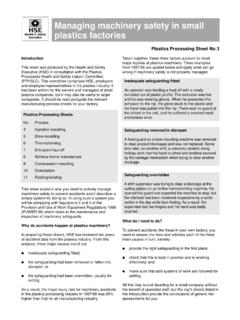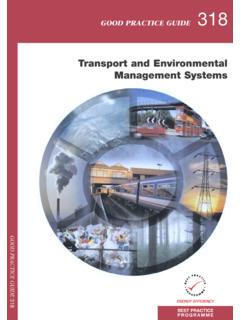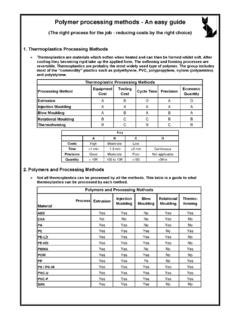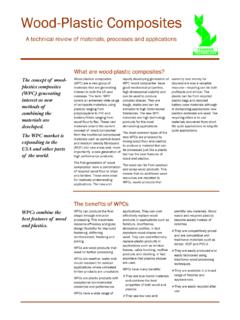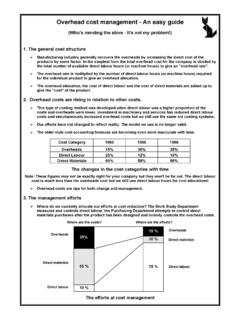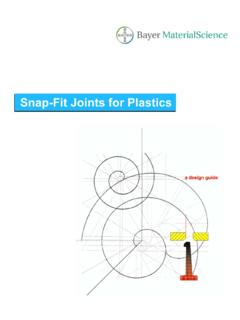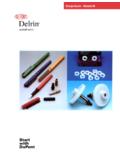Transcription of Design Guides for Plastics - Tangram
1 April 2009 Design Guides for Plastics Clive Maier, Econology Ltd TANGRAMTECHNOLOGY This publication is made up of a series of articles published in Plastics and Rubber Weekly as a piece work. The kind assistance of the author and PRW is acknowledged in the publication of the work. The publication will be updated in a regular basis as new sections of the guide are published by PRW. The Design hints in this booklet are given in good faith and represent current good practice. The short nature of the hints means that not all information can be included. No responsibility can be taken for any errors or consequential damages resulting from using these hints.
2 This publication may be freely reproduced except for sale or advertising purposes. It may be hosted on web sites for free downloading providing that it is used in it s entirety and that reference is made to the original publication. Clive Maier 2004 Typeset by Tangram Technology Ltd. Contents Preface .. 1 Introduction .. 2 Injection 4 Basics 1. Wall thickness .. 5 2. 6 3. Ribs .. 7 4. Bosses .. 10 5. Design for recycling .. 13 Special features 6. Living hinge .. 18 7. Bearings .. 20 8. Gears .. 23 Assembly 9. Press fits .. 28 10. Snap-fits .. 29 11. Hot air staking .. 33 12. Ultrasonic welding.
3 38 13. Hot plate welding .. 40 14. Spin welding .. 41 15. Friction welding .. 42 16. Induction welding .. 43 17. Laser 44 18. Adhesive and solvent bonding .. 45 Special techniques 19. Design for outsert moulding .. 50 20. Design for gas assist injection moulding .. Planned 21. Design for profile extrusion .. Planned Blow 22. Design for extrusion blow moulding .. Planned 23. Design for thermoforming .. Planned Design information 24. Design information 63 April 2009 April 2009 1 Preface This set of hints and tips for Plastics product designers is intended as a source book and an 'aide m moire' for good Design ideas and practices.
4 It is a source book for Plastics product designers at all levels but it is primarily aimed at: student designers carrying out Design work for all levels of academic studies; non- Plastics specialists involved in the Design of Plastics products; Plastics specialists who need to explain their Design decisions and the Design limitations to non- Plastics specialists. The book covers each topic in a single page to provide a basic reference to each topic. This space constraint means that each topic is only covered to a basic level. Detailed plastic product Design will always require detailed knowledge of the application, the processing method and the selected plastic.
5 This information can only be provided by raw materials suppliers, specialist Plastics product designers and Plastics processors but there is a need to get the basics of the product Design right in the first instance. Using the hints and tips provided in this guide will enable designers to reduce initial errors and will lead to better and more economic Design with Plastics . I hope this short work will improve the basic Design of Plastics products and if it can do this then it will have served it s objectives. Clive Maier ECONOLOGY Ltd. 1 April 2009 modified by control of molecular weight and by additives such as reinforcements.
6 The number of different grades of Plastics materials available to the designer now approaches 50,000. The importance - and the difficulty - of making the right choice is obvious. Plastics can be grouped into categories that have roughly similar behaviour. Thermoplastics undergo a physical change when processed; the process is repeatable. Thermosets undergo a chemical change; the process is irreversible. A key distinction between thermoplastics relates to the molecular arrangement. Those with random tangled molecules are called amorphous. Those with a degree of molecular arrangement and ordering are called semi-crystalline.
7 The difference is significant. For example, most amorphous materials can be fully transparent. And the more crystalline a material is, the less likely it is to have a wide 'rubbery' processing region, so making it less suitable for stretching processes like blow moulding and thermoforming Designers must Design for process as well as purpose and material. In single-surface processes for example, there is only indirect control over the form of the second surface. Design must take this limitation into account. 2 Good Design is important for any manufactured product but for Plastics it is absolutely vital. We have no instinct for Plastics .
8 Most of those we use today have been around for little more than two generations. Compare that with the thousands of years of experience we have with metals. And Plastics are more varied, more complicated. For most designs in metals, there is no need to worry about the effects of time, temperature or environment. It is a different story for Plastics . They creep and shrink as time passes; their properties change over the temperature range of everyday life; they may be affected by common household and industrial materials. The philosopher Heidegger defined technology as a way of arranging the world so that one does not have to experience it.
9 We can extend his thought to define Design as a way of arranging technology so that we do not have to experience it. In other words, good Design delivers function, form and technology in objects that meet the needs of users without making demands on them. The well-designed object gives pleasure or at least satisfaction in use, and does what it should do without undue concern. In these Design Guides we will set out the basics of good Design for Plastics . The rules and recommendations we give will necessarily be generalisations. They will apply often but not invariably to thermoplastics, frequently but not exclusively to injection moulding.
10 The basic advice will be good but because Plastics are so complex and varied the golden rule must always be to consider carefully whether the advice needs adjusting to suit your particular application. Good Design combines concept with embodiment. Unless the two are considered together, the result will be an article that cannot be made economically or one that fails in use. This is particularly important for Plastics . It is vital to choose the right material for the job. When that is done, it is equally important to adapt the details of the Design to suit the characteristics of the material and the limitations of the production process.
